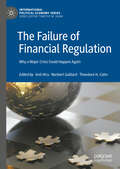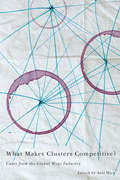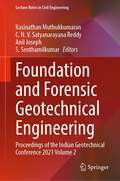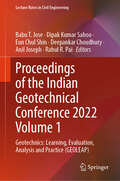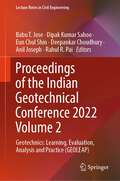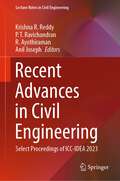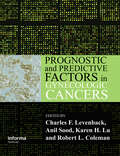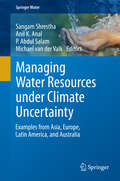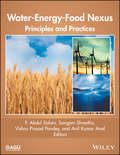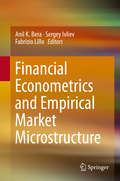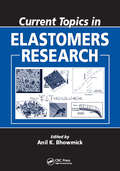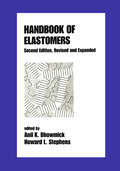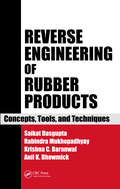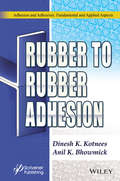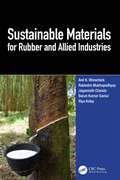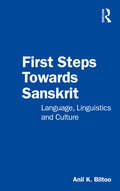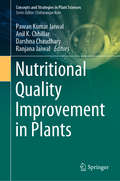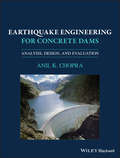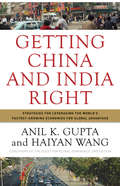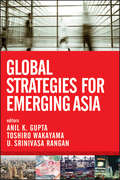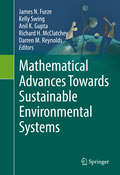- Table View
- List View
The Failure of Financial Regulation: Why a Major Crisis Could Happen Again (International Political Economy Series)
by Norbert Gaillard Anil Hira Theodore H. Cohn“This publication could not be more timely. Little more than a decade after the global financial crisis of 2008, governments are once again loosening the reins over financial markets. The authors of this volume explain why that is a mistake and could invite yet another major crisis.”—Benjamin Cohen, University of California, Santa Barbara, USA“Leading political scientists from several generations here offer historical depth, as well as sensible suggestions about what reforms are needed now.”—John Kirton, University of Toronto, Canada, and Co-founder of the G7 Research Group“A valuable antidote to complacency for policy-makers, scholars and students.”—Timothy J. Sinclair, University of Warwick, UKThis book examines the long-term, previously underappreciated breakdowns in financial regulation that fed into the 2008 global financial crash. While most related literature focuses on short-term factors such as the housing bubble, low interest rates, the breakdown of credit rating services and the emergence of new financial instruments, the authors of this volume contend that the larger trends in finance which continue today are most relevant to understanding the crash. Their analysis focuses on regulatory capture, moral hazard and the reflexive challenges of regulatory intervention in order to demonstrate that financial regulation suffers from long-standing, unaddressed and fundamental weaknesses.
What Makes Clusters Competitive?
by Anil HiraWhile global competitiveness is increasingly invoked as necessary for economic success stories, there are few answers available about how it can be achieved or maintained. The idea of stimulating industries to spur on economies is often proposed, but industrial policy can be seen as a boondoggle of government spending, and theorists of globalization are doubtful that such efforts can succeed in a world of fragmented supply chains. What Makes Clusters Competitive? tests fundamental theoretical hypotheses about what makes industries competitive in a globalized world by using the wine industries of several countries as case studies: British Columbia (Canada), Extremadura (Spain), Tuscany (Italy), South Australia, and Chile. Taking into account historical and location-specific characteristics, and drawing out policy lessons for other regions that would like to promote their industries, this volume demonstrates the value of applying cluster theory to understand market forces, while also describing the forces underlying the development of the wine industry in a range of different settings. An excellent resource for those interested in what makes industries succeed or struggle, What Makes Clusters Competitive? offers guidance for policymakers and the private sector on how to promote local industries. Contributors include David Aylward, Alexis Bwenge, Sara Daniele, F.J. Mesías Díaz, Cristian Felzenstein, Husam Gabreldar, F. Pulido García, Sarah Giest, Elisa Giuliani, Andy Hira, Mike Howlett, A.F. Pulido Moreno, and Oriana Perrone.
What Makes Clusters Competitive?: Cases from the Global Wine Industry
by Anil HiraWhile global competitiveness is increasingly invoked as necessary for economic success stories, there are few answers available about how it can be achieved or maintained. The idea of stimulating industries to spur on economies is often proposed, but industrial policy can be seen as a boondoggle of government spending, and theorists of globalization are doubtful that such efforts can succeed in a world of fragmented supply chains. What Makes Clusters Competitive? tests fundamental theoretical hypotheses about what makes industries competitive in a globalized world by using the wine industries of several countries as case studies: Extremadura (Spain), Tuscany (Italy), South Australia, Chile, and British Columbia (Canada), Taking into account historical and location-specific characteristics, and drawing out policy lessons for other regions that would like to promote their industries, this volume demonstrates the value of applying cluster theory to understand market forces, while also describing the forces underlying the development of the wine industry in a range of different settings. An excellent resource for those interested in what makes industries succeed or struggle, What Makes Clusters Competitive? offers guidance for policymakers and the private sector on how to promote local industries. Contributors include David Aylward, Alexis Bwenge, Sara Daniele, F.J. Mesías Díaz, Christian Felzenstein, Husam Gabreldar, F. Pulido García, Sarah Giest, Elisa Giuliani, Andy Hira, Mike Howlett, A.F. Pulido Moreno, and Oriana Perrone.
Provider-Led Population Health Management: Key Healthcare Strategies in the Cognitive Era
by Karen Ezekiel Handmaker Richard Hodach Michael Weiner Anil Jain Paul GrundyProvider-Led Population Health Management draws connections among the new care-delivery models, the components of population health management, and the types of health IT that are required to support those components. The key concept that ties all of this together is that PHM requires a high degree of automation to reach everyone in a population, engage those patients in self-care, and maximize the chance that they will receive the proper preventive, chronic, and acute care. In the course of explaining how to do this, we describe how health-care organizations are transforming themselves to manage population health and prepare for value-based reimbursement. The ACO, PCMH, and CIN models are discussed, and the advent of bundled payments will also have a major impact on hospital and post-acute care. But at its core, the transition to accountable care centers on care teams that take responsibility for managing and coordinating the services provided to individual patients. These care teams must also engage patients in caring for themselves and improving their health behavior. As care teams become more sophisticated, many of them will use Lean thinking to continuously improve their own work processes. The book is laid out in three sections that progress from the general to the particular aspects of population health management. Section 1, entitled "New Delivery Models," first explains what PHM is and why it''''s important. Ensuing chapters cover ACOs and patient-centered medical homes, which are the favored vehicles for PHM. Section 2, "How to Get There," discusses some fundamentals of the new delivery models, starting with the impact of Meaningful Use on the IT infrastructure that provider organizations must build to operationalize PHM. Other chapters in this section address clinical integration, predictive-modeling applications, and the return on investment in IT solutions that help organizations take advantage of value-based payments. Section 3, "Implementing Change," describes how organizations can use health IT to manage population health. This begins with the basics of care coordination and moves on to advanced methods of care management that utilize Lean thinking. Following a chapter on overall methods of patient engagement, we finish up with a discussion of post-discharge automation, which is another way to involve patients in their own care. Finally, in a brief concluding chapter, we suggest some next steps for organizations heading down the road to population health management. While this book is intended for health-care executives and policy experts, anyone who is interested in health care can learn something from its exploration of the major issues that are stirring health care today. In the end, the momentous changes going on in health care will affect all of us. See what others are saying about Provider-Led Population Health Management: This book is one of the best primers available on the rapidly evolving technologies that help healthcare providers manage population health. The automation of care management through information technology, as the book astutely notes, enables medical homes to execute the manifold tasks of population health management cost effectively and without overburdening care teams. Paul Grundy, MD, MPH - IBM''''s Global Director of Healthcare Transformation President, Patient-Centered Primary Care Collaborative Dr. Richard Hodach''''s book addresses the most critical elements for providers as they transform themselves to provide population health management. His review of new delivery models, and his discussion of what is needed to deliver population health are right on point. There is even a road map on how to implement the changes necessary to deliver population health. What makes the book most interesting is the way in which Richard draws the connections among the new delivery models, the components of population health management, and the role of health information technology necessary to support population health management. These connections are critically i...
Foundation and Forensic Geotechnical Engineering: Proceedings of the Indian Geotechnical Conference 2021 Volume 2 (Lecture Notes in Civil Engineering #295)
by C. N. V. Satyanarayana Reddy Kasinathan Muthukkumaran Anil Joseph S. SenthamilkumarThis book comprises the select peer-reviewed proceedings of the Indian Geotechnical Conference (IGC) 2021. The contents focus on Geotechnics for Infrastructure Development and Innovative Applications. This book covers topics related to shallow foundations, pile & piled raft foundation, geotechnical design of foundation, wind turbine foundation, foundations on problematic soils, forensic geotechnical engineering, and case studies on geotechnical failures. This book is of interest to those in academia and industry.
Proceedings of the Indian Geotechnical Conference 2022 Volume 1: Geotechnics: Learning, Evaluation, Analysis and Practice (GEOLEAP) (Lecture Notes in Civil Engineering #476)
by Deepankar Choudhury Anil Joseph Babu T. Jose Dipak Kumar Sahoo Eun Chul Shin Rahul R. PaiThis book comprises the select proceedings of the Indian Geotechnical Conference (IGC) 2022. The contents focus on recent developments in geotechnical engineering for a sustainable world. The book covers behaviour of soils and soil–structure interaction, soil stabilization, ground improvement and land reclamation, shallow and deep foundations, geotechnical, geological and geophysical investigation, rock engineering, tunnelling and underground structures, slope stability, landslides and liquefaction, earth retaining structures and deep excavations, geosynthetics engineering, geo-environmental engineering, sustainable geotechnics and landfill design, geo-hydrology, dam and embankment engineering, earthquake geotechnical engineering, transportation geotechnics, forensic geotechnical engineering and retrofitting of geotechnical structures, offshore geotechnics, marine geology and sub-sea site investigation, computational, analytical and numerical modelling, reliability in geotechnicalengineering. The contents of this book are useful to researchers and professionals alike.
Proceedings of the Indian Geotechnical Conference 2022 Volume 2: Geotechnics: Learning, Evaluation, Analysis and Practice (GEOLEAP) (Lecture Notes in Civil Engineering #477)
by Deepankar Choudhury Anil Joseph Babu T. Jose Dipak Kumar Sahoo Eun Chul Shin Rahul R. PaiThis book comprises the select proceedings of the Indian Geotechnical Conference (IGC) 2022. The contents focus on recent developments in geotechnical engineering for a sustainable world. The book covers behaviour of soils and soil–structure interaction, soil stabilization, ground improvement and land reclamation, shallow and deep foundations, geotechnical, geological and geophysical investigation, rock engineering, tunnelling and underground structures, slope stability, landslides and liquefaction, earth retaining structures and deep excavations, geosynthetics engineering, geo-environmental engineering, sustainable geotechnics and landfill design, geo-hydrology, dam and embankment engineering, earthquake geotechnical engineering, transportation geotechnics, forensic geotechnical engineering and retrofitting of geotechnical structures, offshore geotechnics, marine geology and sub-sea site investigation, computational, analytical and numerical modelling, reliability in geotechnical engineering. The contents of this book are useful to researchers and professionals alike.
Recent Advances in Civil Engineering: Select Proceedings of ICC-IDEA 2023 (Lecture Notes in Civil Engineering #398)
by Krishna R. Reddy Anil Joseph R. Ayothiraman P. T. RavichandranThis book presents the select proceedings of International Conference on Civil Engineering: Innovative Development in Engineering Advances (ICC-IDEA 2023). This book covers the latest research in the areas of geotechnical engineering, geomatics, geosciences, remote sensing, geographical information systems, surveying and geo-spatial engineering, environmental engineering, and many more. The book is useful for researchers and professionals in civil engineering.
Dare to Lead
by Anil K KhandelwalDare to Lead is the fascinating story of how Anil K. Khandelwal transformed Bank of Baroda (BOB) from being just another public sector bank into one of the most valuable brands in Indian banking. This is the story of the leadership challenges, management solutions and personal and professional excitement the author experienced in transforming the 97-year-old bank into a modern, tech-savvy, customer-centric bank. This book is an excellent blueprint for undertaking transformation in large, geographically dispersed public sector enterprises. It describes how a large-sized bank was transformed on all parameters with clear vision, execution discipline, customer centricity and people engagement. The author emphasizes that large-scale transformation can be undertaken successfully only if the CEO shows courage to change the status quo and mobilize the human effort within the organization. The story of BOB's transformation has captured international attention and finds its mention in Harvard Business Review, Human Resource Development International and the book The India Way by the Wharton School faculty.
Prognostic and Predictive Factors in Gynecologic Cancers
by Charles F Levenback Anil K Sood Karen H Lu Robert L ColemanGynecologic oncology takes a fresh look at a critical aspect of cancer treatment planning. An international team of authors reviews the traditional prognostic and predictive factors such as tumor grade, histologic subtype, and grade and then goes a step further to review the growing number of molecular discoveries that have increasing clinical significance. The book is organized into comprehensive sections on ovarian, endometrial and cervical cancer and includes up to date reviews, newly discovered molecular pathways, genetic markers, molecular imaging techniques, and their relevance to clinical medicine.Prognostic and Predictive Factors in Gynecologic Oncology is illustrated with over 100 figures and is essential reading for oncologists, translational and basic scientists, as well as fellows, residents and students with a special interest in gynecologic oncology.
Managing Water Resources under Climate Uncertainty
by Anil K. Anal Sangam Shrestha P. Abdul Salam Michael van der ValkThis book aims to come up with views to address the queries of planners, policymakers, and general people for water resources management under uncertainty of climate change, including examples from Asia and Europe with successful adaptive measures to change the challenge of climate change into opportunities. The availability of clean water is a major global challenge for the future due to a rapidly growing population and urbanization where further stress in water resources is expected due to the impact of climate change. The wide range of impacts includes for example changes in hydrology, moisture availability, spatial and temporal variations in magnitude of stream flow, and dwindling of water levels with adverse effect on wetlands and ecosystem. As a consequence, water management has become a serious issue and was identified as a global societal challenge, and climate change forecasting has become one of the key issues in recent research on sustainable water resources management.
Water-Energy-Food Nexus: Principles and Practices
by Anil K. Anal Sangam Shrestha P. Abdul Salam Vishnu Prasad PandeyWater, energy and food are key resources to sustain life, and are the fundamental to national, regional and global economies. These three resources are interlinked in multiple ways, and the term “nexus” captures the interconnections. The nexus has been discussed, debated, researched, and advocated widely but the focus is often on the pairings of “water-energy” or “water-food” or “energy-food”. To really benefit from the nexus approach in terms of resource use efficiency it is essential to understand, operationalize and practice the nexus of all three resources. As demand for these resources increases worldwide, using them sustainability is a critical concern for scientists and citizens, governments and policy makers. Volume highlights include: Contributions to the global debate on water-energy-food nexus Examples of the nexus approach in practice from different regions of the world Perspectives on the future of the nexus agenda Water-Energy-Food Nexus: Theories and Practices is a valuable resource for students, research scholars and professionals in academic institutions with strong interests in interdisciplinary research involving geography, earth science, environmental science, environmental management, sustainability science, international development, and ecological economics. The volume will also be useful for professionals, practitioners and consultants in /NGOs, government, and international agencies.
Financial Econometrics and Empirical Market Microstructure
by Anil K. Bera Sergey Ivliev Fabrizio LilloIn the era of Big Data our society is given the unique opportunity to understand the inner dynamics and behavior of complex socio-economic systems. Advances in the availability of very large databases, in capabilities for massive data mining, as well as progress in complex systems theory, multi-agent simulation and computational social science open the possibility of modeling phenomena never before successfully achieved. This contributed volume from the Perm Winter School address the problems of the mechanisms and statistics of the socio-economics system evolution with a focus on financial markets powered by the high-frequency data analysis.
Current Topics in Elastomers Research
by Anil K. BhowmickFrom weather-proof tires and artificial hearts to the o-rings and valve seals that enable successful space exploration, rubber is an indispensable component of modern civilization. Stiff competition and stringent application requirements foster continuous challenges requiring manufacturers to fund ever-expanding research projects. However, this vas
Handbook of Elastomers (Plastics Engineering)
by Anil K. Bhowmick Howard L. StephensProvides the latest authoritative research on the developments, technology, and applications of rubbery materials. Presents structures, manufacturing techniques, and processing details for natural and synthetic rubbers, rubber-blends, rubber composites, and thermoplastic elastomers. 80% revised and rewritten material covers major advances since publication of the previous edition.
Reverse Engineering of Rubber Products: Concepts, Tools, and Techniques
by Anil K. Bhowmick Saikat Das Gupta Rabindra Mukhopadhyay Krishna C. BaranwalReverse engineering is widely practiced in the rubber industry. Companies routinely analyze competitors' products to gather information about specifications or compositions. In a competitive market, introducing new products with better features and at a faster pace is critical for any manufacturer. Reverse Engineering of Rubber Products: Concepts,
Rubber to Rubber Adhesion
by Anil K. Bhowmick Dinesh Kumar KotneesThis book covers various aspects of rubber to rubber adhesion. Rubber is a polymer whose glass transition temperature is well below the room temperature and hence the chains are very mobile at room and higher temperatures. This property makes this material very versatile. Rubber is used in a large number of applications ranging from underground mining to tire to space shuttle. In all these cases, compounded rubbers are used in laminates and joined. Higher the adhesion, higher will be the joint strength. The principles taught in adhesion science and technology are extensively used to prepare better joints and hence useful products. The subject of this book is important theoretically and it has practical implications as well. Rubber to rubber adhesion is all pervading. Hence, the book will be used by academicians, R & D personnel, company people, and rubber and adhesion practitioners. The book serves to satisfy a wide range of disciplines (polymer, materials, chemical, chemistry, mechanical etc.) and hence starts with with an introduction on rubber, then characterization of rubber, rubber surface and joints and finally covers other chapters on rubber to rubber adhesion. Scientific aspects to understand the technology are highlighted. It gives a comprehensive treatment on Adhesion between Unvulcanized Elastomers, Self- healing of Elastomers, Adhesion between Compounded Elastomers by co-crosslinking, Adhesion between partially Vulcanized Compounded Rubber and partially Vulcanized Compounded Rubber, Adhesion between Vulcanized Rubber and Unvulcanized Rubber- or partially Vulcanized Rubber, and Adhesion between Vulcanized Rubber and Vulcanized Rubber.
Sustainable Materials for Rubber and Allied Industries
by Anil K. Bhowmick Rabindra Mukhopadhyay Jagannath Chanda Barun Kumar Samui Riya KoleyTraditional rubber products contain rubber and multiple additives. Unfortunately, many of these materials are obtained from fossil fuel sources, resulting in environmental hazards, overuse of dwindling reserves, and reliance on a volatile petroleum market price. The need for the use of more sustainable materials in the rubber industry is clear, and advances are being made towards this goal. This unique book highlights these developments in the science and technology of sustainable materials in the rubber and allied industries and covers both rubber materials and the ingredients necessary to make a product and also legislation and regulations pertaining to these.KEY FEATURES Offers expert perspectives from both industry and academia Addresses real‑world problems and offers solutions Provides up‑to‑date literature on sustainable materials in these industries Discusses natural and synthetic rubbers and their sustainable monomers and thermoplastic elastomers Details sustainable fillers, curing agents and activators, antidegradants, resins, process aids, etc Deals with sustainable textiles and steel for reinforcement Covers rubber recycling as well as regulations and legislation This book is aimed at engineers, scientists, and researchers in materials science, chemistry, and related fields who are seeking to provide a sustainable alternative for this crucial industry.
First Steps Towards Sanskrit: Language, Linguistics and Culture
by Anil K. BiltooFirst Steps Towards Sanskrit: Language, Linguistics and Culture is an accessible first introduction to this ancient Indian language. Complete beginners are introduced to the language from scratch. Key terms are explained clearly and there is an extensive glossary to assist the reader who is unfamiliar with the terminology of language learning. By the end of the book, learners will have grasped the basics of the language and be prepared to engage readily in an introductory college or university course or through private study. The addition of cultural, linguistic and historical notes will appeal to learners with diverse interests, ranging from religious studies and philosophy to yoga and comparative or historical linguistics. The book includes references to classical and modern European languages. Parallels are also drawn with Indic languages where these are relevant, particularly as concerns the writing system. No knowledge of any language other than English is, however, presupposed. This book is ideal for both self-study and in-class use as a primer or core text for pre-sessional courses.
Nutritional Quality Improvement in Plants (Concepts and Strategies in Plant Sciences)
by Pawan Kumar Jaiwal Anil K. Chhillar Darshna Chaudhary Ranjana JaiwalThis book presents a detailed overview and critical evaluation of recent advances and remaining challenges in improving nutritional quality and/or avoiding the accumulation of undesirable substances in plants using a variety of strategies based on modern biological tools and techniques. Each review chapter provides an authoritative and insightful account of the various aspects of nutritional enhancement of plants. In the course of the last two decades, several food crops rich in macro- and micronutrients have been developed to improve health and protect a large section of the populace in developing countries from chronic diseases. Providing extensive information on these developments, this book offers a valuable resource for all researchers, students and industrialists working in agriculture, the plant sciences, agronomy, horticulture, biotechnology, food and nutrition, and the soil and environmental sciences.
Earthquake Engineering for Concrete Dams: Analysis, Design, and Evaluation
by Anil K. ChopraA comprehensive guide to modern-day methods for earthquake engineering of concrete dams Earthquake analysis and design of concrete dams has progressed from static force methods based on seismic coefficients to modern procedures that are based on the dynamics of dam–water–foundation systems. Earthquake Engineering for Concrete Dams offers a comprehensive, integrated view of this progress over the last fifty years. The book offers an understanding of the limitations of the various methods of dynamic analysis used in practice and develops modern methods that overcome these limitations. This important book: Develops procedures for dynamic analysis of two-dimensional and three-dimensional models of concrete dams Identifies system parameters that influence their response Demonstrates the effects of dam–water–foundation interaction on earthquake response Identifies factors that must be included in earthquake analysis of concrete dams Examines design earthquakes as defined by various regulatory bodies and organizations Presents modern methods for establishing design spectra and selecting ground motions Illustrates application of dynamic analysis procedures to the design of new dams and safety evaluation of existing dams. Written for graduate students, researchers, and professional engineers, Earthquake Engineering for Concrete Dams offers a comprehensive view of the current procedures and methods for seismic analysis, design, and safety evaluation of concrete dams.
Getting China and India Right
by Anil K. Gupta Haiyan WangThis book is the first strategic guide for multi-national corporations (MNCs)who are contemplating expanding into both China and India. Gupta and Wang explain how many MNCs view China and India solely from the lens of off-shoring and cost-reduction, and focusing their marketing strategies on only the top 5-10% of the population. This is a missed opportunity. China and India are the only two countries that constitute four realities that are strategically crucial for the global enterprise:Both provide mega-markets for almost every product and serviceBoth have platforms that will dramatically reduce the company's global cost structureBoth have platforms that will significantly boost the company's global technology and innovation baseBoth are springboards for the mergence of new fearsome global competitors.This book aims to shed light on the brutal competition for markets and resources in China and India as well as lays out the strategic action implications for those companies who want to emerge as the global players of tomorrow.
Global Strategies for Emerging Asia
by Anil K. Gupta U. Srinivasa Rangan Toshiro WakayamaThe multinational corporate guide for thriving in the Asian marketplace Led by China and India, the rise of emerging Asia is transforming the structure of the global economy. By 2025, if not sooner, China will almost certainly overtake the U.S. to become the world's largest economy. By then, India is likely to have overtaken Japan to become the world's third largest economy, after China and the U.S. Besides China and India, Asia also includes other fast-growing economies such as Indonesia, Malaysia, Philippines, Thailand, and Vietnam. Added together, by 2025, these developments are likely to make Asia's economy larger than those of the U.S. and Europe combined. It is clear that, for every large company, leadership in Asia is rapidly becoming critical for leadership globally. This important resource brings together the latest ideas and in-depth case analyses from leading academics and practitioners to provide a comprehensive guide to succeeding in Asia. Explores how to develop a strategy to benefit from new patterns of 21st century trade Explains how companies can fight and win against low-cost competition from Asian companies Shows how to transfer homegrown management practices to Asia Reveals how to safeguard the company's intellectual property in China Brings to light how to leverage India as a platform to revitalize the company's innovation capabilities A resource for competing in today's international market, this book offers executives and managers a guide for navigating the new global reality—that of Asia as the world's emerging center of gravity.
Mathematical Advances Towards Sustainable Environmental Systems
by Anil K. Gupta Darren M. Reynolds James N. Furze Kelly Swing Richard H. McclatcheyThis edited volume focuses on how we can protect our environment and enhance environmental sustainability when faced with changes and pressures imposed by our expansive needs. The volume unites multiple subject areas within sustainability, enabling the techniques and philosophy in the chapters to be applied to research areas in environmental science, plant sciences, energy, biodiversity and conservation. The chapters from expert contributors cover topics such as mathematical modelling tools used to monitor diversity of plant species, and the stability of ecosystem services such as biogeochemical cycling. Empirical research presented here also brings together mathematical developments in the important fields of robotics including kinematics, dynamics, path planning, control, vision, and swarmanoids. Through this book readers will also discover about rainfall-runoff modelling which will give them a better idea of the effects of climate change on the sustainability of water resources at the watershed scale. Modelling approaches will also be examined that maximize readers insights into the global problem of energy transition, i. e. the switch to an energy production system using renewable resources only. Collective and discrete insights are made to assist with synergy which should progress well beyond this book. Insight is also given to assist policy formations, development and implementations. The book has a strong multi-disciplinary nature at its core, and will appeal to both generalist readers and specialists in information technology, mathematics, biology, physics, chemistry and environmental sciences.
IC 814 Hijacked - Novel
by Anil K. Jaggia Saurabh ShuklaWhat was the intelegence failure that led to the hijacking of Indian Airlines Flight IC814 from Kathmandu? Could the aircraft have been stopped at Amritsar airport? Was a commando raid planned on the aircraft? How was Rupin Katyal killed? Was the plane's destination always intended to be Kandahar? Was it merely prophetic that the hijackers had predicted the end of all negotiations on the millennium eve? These and other questions are answered in this blow-by-blow eyewitness account by Flight Engineer Anil K Jaggia who breaks the silence around the hijacking, with investigative reporting by senior correspondent Saurabh Shukla of The Indian Express.
